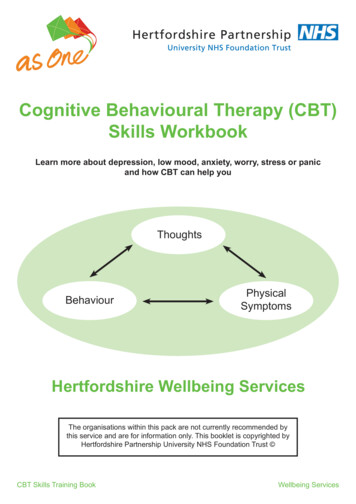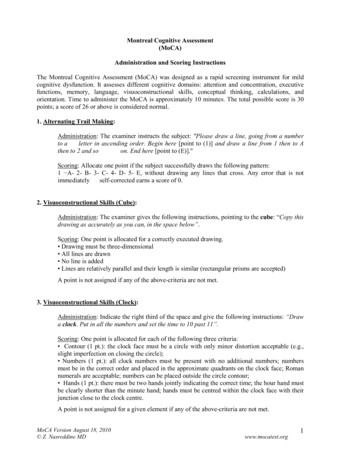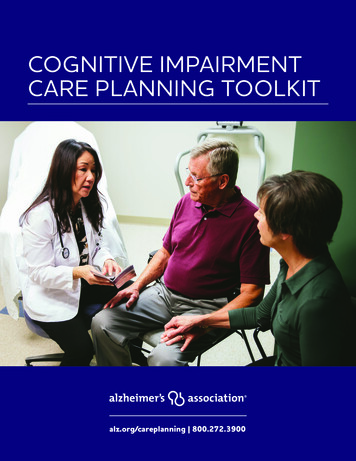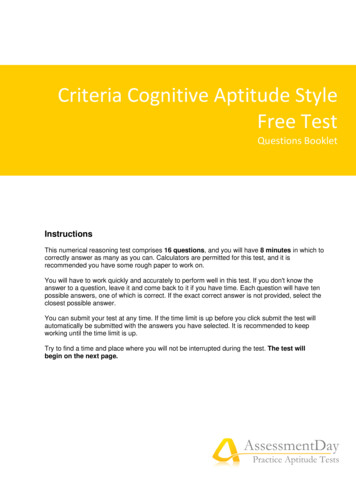
Transcription
COGNITIVE BEHAVIORALTHERAPY STRATEGIESKRISTI L. CRANE, PSY.D.KRISTY M. WATTERS, PSY.D.
INSTRUCTIONSThis book is intended as a practical guide for clinicians who wish to use Cognitive BehavioralTherapy for Depression (CBT-D) with Veterans. It can be used as an additional resourceto Cognitive Behavioral Therapy for Depression in Veterans and Military Servicemembers:Therapy Manual (Wenzel, A., Brown, G. K., & Karlin, B. E., 2011). This resource was created to usein order of typical therapy. The first section (pages 6-31) correlates to the Initial Phase of CBT,the second section (pages 32-99) correlates to the Middle Phase of CBT, and the last section(94-107) correlates to the Later Phase of CBT.The Initial Phase includes a preliminary assessment and case conceptualization tool to assist theclinician with targeting problem areas and identifying evidence-based interventions aimed atreducing depression symptoms. The Initial Phase helps Veterans gain an understanding of thestructure and process of CBT and is used to generate treatment goals. During the Middle Phaseof therapy, the provider and Veteran work together to address treatment goals. The providershould select the most appropriate behavioral and cognitive techniques according to the caseconceptualization. The central focus of this resource is on the actual course of therapy. Asyou review the interventions, we recommend that you consider how each intervention may beindividually applied. The Later Phase of treatment focuses on the Veteran’s progress towardreaching their treatment goals. Specifically, evaluating whether they can apply techniquesappropriately to help alleviate depressive symptoms. The Later Phase also focuses on creatinga relapse prevention plan.Suggestions for using the guide: Select handouts you are most likely to use and provide the Veteran with their owncopies. Keep quantities of selected handouts in folders so they will be easy to offer the Veteran. Handouts can reinforce and validate ideas you have presented in session. They canserve as transitional objects for the Veteran as they prepare for discharge and relapseprevention planning.The contents of this manual do not represent the views of the Departmentof Veterans Affairs (VA) or the U.S. government.This manual was supported by a clinical educator grant from the VA SouthCentral Mental Illness Research, Education and Clinical Center (MIRECC).
Table of ContentsWhat is Cognitive Behavioral Therapy? . 6What to Expect? .7What is Cognitive Behavioral Therapy? .8Behavioral Model . 9Cognitive Behavioral Model.10Phases of CBT . 11Steps of CBT. 12Session Format. 13Assessment, Case Conceputalization, and Treatment Planning . 15Patient Health Questionnaire (PHQ-9). 16Assessment/Case Conceptualization/Treatment Planning. 17Case Conceptualization Worksheet Example. 24Case Conceptualization Worksheet . 26GOAL SETTING. 27SMART Goals. 28Cost-Benefit Analysis of Change. 31Behavioral Strategies. 32Activity Monitoring . 33Values Identification .34Activity Monitoring Log . 36Activity and Mood Log. 37Examples of Pleasant Activities. 39Activity Scheduling.43Increase Pleasure and Achievement .44Behavioral Activation .45
Graded Task Assignments.46Relaxation: Benefits & Tips .48Deep Breathing . 51Progressive Muscle Relaxation. 53Guided Imagery . 56Relaxation Practice Record . 58Relaxation Training Apps . 59Schedule Worry Time .60Worry Journal. 61Problem Solving (ITCH) Example . 62Problem Solving (ITCH) .64Cognitive Strategies.66Anatomy of an Emotion Example . 67Anatomy of an Emotion.68Automatic Thoughts.69Emotions . 71Combining Thoughts and Behaviors. 72Thought-Stopping Techniques . 74Downward Arrow Technique. 75Thought Record Example. 77Thought Record . 78Thinking Traps. 79Socratic Questioning Example . 82Socratic Questioning. 83Challenging Questions Worksheet Example.84Challenging Questions Worksheet. 85Thought Record .86
What is the difference between thoughts and core beliefs. 87Life History Review . 88Healthy Core Beliefs .90Unhealthy Core Beliefs . 91Modifying Core Beliefs. 92Guilt and Blame . 93Relapse Prevention.94Life Events that May Influence Mood. 95Monitoring Progress .96Relapse Prevention Plan . 97Coping Cards.100Notes. 101Resources. 103
WHAT IS COGNITIVEBEHAVIORAL THERAPY?(PSYCHOEDUCATION)6
WHAT TO EXPECT? CBT is evidence based. CBT has been well tested in research studies and has been proven tobe effective in treating depression. CBT is structured. You should expect to have a good idea of where you’re going and howto get there. So, we will set clear goals to create a roadmap that will help us find the bestway to improve your symptoms. During each session we will set an agenda for what we wantto discuss, we will discuss last week’s practice assignment, discuss agenda items, and thenassign new homework. CBT is psychoeducational. The entire program is skill based and involves you enhancingyour skill set. You will learn different “tools” to help cope with your current problems thatyou will be able to take with you when treatment is over. CBT is goal oriented. We will work together to identify and achieve specific treatment goals.We will track your progress on your goals and problem solve ways to reach them. CBT is time limited. Treatment is usually 16-20 weeks. CBT requires you to attend weekly sessions. Regular attendance is essential to recovery.Sessions are approximately 50 minutes long. CBT requires active participation. What you get out of treatment is a direct result of theeffort you put into it. Just showing up is not enough. We need you to be an active partner inyour treatment process. CBT has a home practice requirement. Treatment is challenging and takes dailycommitment from you to be successful. CBT is not a one time therapy. It is not an instantchange that you will immediately notice after one session. Practice assignments help putyour new skills to use. CBT focuses on the here and now. Treatment emphasizes how depression is maintained inyour present life. CBT is collaborative. Although the therapist is the expert on CBT, you are the expert onyourself. We will work together to tailor your treatment to your needs.7
WHAT IS COGNITIVE BEHAVIORAL THERAPY?Cognitive Therapy Behavioral Therapy Cognitive Behavioral TherapyCognitive Model: Cognitive refers to the act of knowing or recognizing our experiences. The cognitive model focuses on thinking and how our thoughts are connected to ourmood, physiological responses, and behaviors Cognitive therapy will teach you to change your thoughts, beliefs, and attitudes thatcontribute to your depression.Two people can be faced with similar situations, but because they think about those situationsin different ways, they have different reactions to them.8
BEHAVIORAL MODEL“Depressed individuals do not get enough positive reinforcement from interactions with theirenvironment to maintain happy, adaptive behavior” (Wenzel, Brown, & Karlin, 2011).Two behavioral patterns associated with depression:Low level of positive feelings from engaging in life activitiesNo longer participating in enjoyable activitiesNot getting as much enjoyment in activities as in the pastNo longer enjoying socializing with othersHigh rate of negative consequencesFrequently noticing things are not working outFeeling a lack of support and understanding from othersWenzel, A., Brown, G. K., & Karlin, B. E. (2011). Cognitive Behavioral Therapy for Depression in Veterans and Military Servicemembers: TherapyManual. Washington, DC: U.S. Department of Veteran Affairs.9
COGNITIVE BEHAVIORAL MODELWenzel, A., Brown, G. K., & Karlin, B. E. (2011). Cognitive Behavioral Therapy for Depression in Veterans and Military Servicemembers: TherapyManual. Washington, DC: U.S. Department of Veteran Affairs.10
PHASES OF CBTWenzel, A., Brown, G. K., & Karlin, B. E. (2011). Cognitive Behavioral Therapy for Depression in Veterans and Military Servicemembers: TherapyManual. Washington, DC: U.S. Department of Veteran Affairs.11
STEPS OF CBTCognitive Behavioral Therapy helps people become more aware of the relationship betweentheir thoughts, feelings, and emotions.Step 1Step 2Step 3Become aware of:Automatic thoughtsFeelingsCore beliefsBehaviorsPhysical reactionsEnvironmentExamination:Thoughts are not factsExamine the evidence, look for proofQuestion and challenge irrational beliefsDon’t believe everything you thinkCreate alternative thoughts:Increase positive self talkReduce negative automatic thoughtsReplace irrational beliefs with more rational ones12
SESSION FORMAT Complete PHQ-9 in waiting room Check in: Review scores Review chart since last session Mood check What was your week like? What has your mood been like, compared to other weeks? Medication Are medications being taken? Changes in medications? Drug/Alcohol Has there been a change in your alcohol or drug use since last session? Bridge from last session What did we talk about last session that was important? What did you learn? Was there anything that bothered you about our last session? Anything you were reluctant to or did not say?13
Agenda setting Did anything happen this week that is important to discuss? What topics do you want to put on the agenda? Therapist agenda items presented. Review of homework Which homework did you do? Which homework did you not do? What did you learn? Discussion of Agenda items Addressed in agreed upon order Identify key thoughts/behaviors Implement a CBT strategy Encourage the application of strategies Assists in generalizing strategies Periodic summaries/feedback What are you going to take away from our discussion? What are you going to do differently as a result of our discussion? Homework assignment for next week On a scale from 0 to 100, how likely are you that you will do your homework? Final summary Session feedback14
ASSESSMENT, CASECONCEPTUALIZATION, ANDTREATMENT PLANNING15
PATIENT HEALTH QUESTIONNAIRE (PHQ-9)Over the last week, how often have you been bothered by any of the following problems?(circle to indicate your answer)Not at Several More thanNearly everyallDayshalf the days dayLittle interest or pleasure in doing things0123Feeling down, depressed, or hopeless0123Trouble falling or staying asleep, or sleeping toomuch0123Feeling tired or having little energy0123Poor appetite or overeating0123Feeling bad about yourself—or that you are afailure or have let yourself or your family down0123Trouble concentrating on things, such asreading the newspaper or watching television0123Moving or speaking so slowly that other peoplecould have noticed. Or the opposite—being sofidgety or restless that you have been movingaround a lot more than usual0123Thoughts that you would be better off dead, orof hurting yourself in some way0123Add columns:TOTAL:If you checked off any problems, how difficulthave these problems made it for you to do yourwork, take care of things at home, or get alongwith other people?Scores:1-910-1415-1920-27Not difficult at allSomewhat difficultVery difficultExtremely difficultNo DepressionMild Depressive SymptomsModerate Depressive SymptomsSevere Depressive SymptomsDeveloped by Drs. Robert L. Spitzer, Janet B.W. Williams, Kurt Kroenke and colleagues, with an educational grant from Pfizer Inc. No permissionrequired to reproduce, translate, display or distribute. Kroenke, K., Spitzer, R. L., & Williams, J. B. W. (2001). The PHQ-9 - Validity of a briefdepression severity measure. Journal of General Internal Medicine, 16, 606-613.16
ASSESSMENT/CASE CONCEPTUALIZATION/TREATMENT PLANNINGBy gathering specific information, you can better determine the factors that are contributing toyour depression. Having a better understanding of your symptoms and how they developed willallow us to create a treatment plan specific to your needs. Work with your therapist to gatherthe information below: Symptoms Formative influences Biological, genetic, and medical factors Situational/interpersonal issues Strengths and barriers Typical automatic thoughts, emotions, and behaviors Core beliefs Hypothesis Goals Treatment plan and selecting strategies17
Symptoms1. Describe the problem:2. How long have you had this problem?3. What is the frequency of your symptoms and how long do they last?4. What has worked and what has not worked in favor of change?Formative influences (Longitudinal analysis)1. What may have triggered this problem?18
2. What other developmental events and formative influences may have shaped your be liefs (family history)?Biological, genetic, and medical factors (Longitudinal analysis)1. Are there any medical issues that contribute to your depression?Situational/interpersonal issues (Cross-sectional analysis)1. What are the circumstances under which the depression commonly and reliably occurs?2. What maintains the problem?3. What is escaped or avoided as a result of depressive symptoms?19
4. How have you attempted to resolve the problem?5. How would your life be different without this problem?Strengths and barriers1. What strengths do you possess that will help you be successful in treatment (e.g., familysupport, motivated in treatment, compliant with medication)?2. What obstacles interfere with your ability to attend weekly sessions (e.g., transporta tion, work schedule, child-care, family obligations, etc.)?3. Have you talked to your family members about coming to therapy? Are they supportiveof your efforts?4. On a scale from 1-10, how ready are you to make this change?5. On a scale from 1-10, how willing are you to make this change?20
6. On a scale from 1-10, how confident are you that you can change?Typical automatic thoughts, emotions, and behaviors1. Think of the last time you were experiencing sadness. What was happening?2. What were you thinking?3. What images were going through your mind?4. What other emotions were your feeling?Core beliefs1. What negative beliefs have you had since childhood that may be contributing to yoursymptoms?21
HypothesisGoalsShort Term Goals:Long Term Goals:22
TREATMENT PLAN/STRATEGIES:Behavioral Strategies:Cognitive Strategies: Activity Monitoring Recognizing Mood Shifts Values Identification Combining Thoughts and Emotions Activity Monitoring Log Thought Stopping Mood Log Downward Arrow Technique Pleasant Activities Use of Thought Change Records Activity Scheduling Identifying Cognitive Errors Increasing Pleasure and Achievement Socratic Questioning Behavioral Activation Challenging Questions Graded Task Assignments Generating Rational Alternatives Relaxation Training Life History Scheduled Worry Time Modifying Core Beliefs Problem Solving Guilt vs. Shame23
CASE CONCEPTUALIZATION WORKSHEET EXAMPLEVeteran Name: Robert JonesDate: August 30, 2018Symptoms: Major Depressive Disorder, Moderate, RecurrentVeteran presents with depressed mood, anhedonia, low energy, a decrease in appetite,feelings of worthlessness, hypersomnia, decrease in socialization, psychomotorretardation, and non-suicidal self-directed violence ideation. Convincingly deniespreparatory behaviors, intent, or plan. He has had these symptoms for the past year andthey reoccur at least once a month, lasting for two weeks at a time. When depressed hedrinks more and isolates from family and friends. He noted this has not helped decreasehis depressive symptoms. He noted playing his guitar and writing music helps decreasehis symptoms.Formative Influences: Robert is a 21-year-old, Caucasian, cisgender, unmarriedmale that grew up in a small town in the Delta of Mississippi. He is the oldest of4 (siblings aged 12, 15, 17). Mother and father are both deceased; they died in acar accident involving a drunk driver. Veteran was the first in his immediate familyto graduate high school and he is the first to enlist in the military. He is now 4credits away from graduating from college with a B.S. in Criminology. Veterandescribed himself as a “popular guy” in his hometown, played many school sports,and was Homecoming King his senior year. He enlisted in the Navy at 19 years oldin the Submarine Electronics Computer Field (SECF) and worked with submarinecommunications systems. Veteran was involved in war games, but never deployedor engaged in combat. Veteran was stationed in Honolulu, HI when he receiveda Red Cross Emergency Notification that both of his parents were deceased.Veteran received a genuine dependency discharge, has moved back home, and isnow the primary caregiver for his siblings.Biological, Genetic, and Medical Factors: Veteran believes his mother may haveexperienced postpartum depression after the birth of his youngest sibling, but denied anyother family history. No known contributing medical factors.Situational Issues/Interpersonal Issues: There are limited opportunities for employmentin his hometown and he’s concerned that he will have to relocate his family further southto find a job that will support him and his siblings. He is the primary caregiver of hissiblings, no other family members within 50-mile radius. Several of Veteran’s friends fromhigh school still live in town; however, he rarely socializes with them and has very limitedfinances. He has never attended therapy. His depression makes it difficult for him tosearch for more opportunities. If he wasn’t depressed he noted he would be more social,find a partner, and be able to feel better about providing for his family.24
Strengths/Barriers: Veteran is young, able-bodied, and reports a willingness to work. Heis seeking mental health support for the first time and reports a desire for change. He isintelligent, computer savvy, and loving.Event 1Event 2Event 3Primary caregiver to siblings4 credits away fromcompleting college degreeTalked to best friend fromhigh school over the phoneAutomatic ThoughtsAutomatic ThoughtsAutomatic Thoughts“My life is ruined.”“I will never finish now; it’suseless to try.”“He sounds like he’s happywith his epressedLet downResentfulBehaviorsBehaviorsBehaviorsAngry outbursts at siblingsfor “little things.”has not gone back toparents grave site.Dropped out of school andhas not contacted schoolabout options.Does not respond to friend’stexts and will not call himback.Core Beliefs: I am a failure. I am a bad son. People are better off without me.Hypothesis: Since the death of his parents, Robert has experienced a number of significantchanges to his life. He has yet to grieve the loss of his parents or his identity as a servicemember and is struggling to accept the new reality of being the primary caregiver for hissiblings. Veteran believes that his future possibilities are now significantly limited and he willbe unable to live a fulfilling life.Veteran’s Goal: “I want to deal with my parents’ deaths and be able to better care for mysiblings.”Treatment Plan/Strategies:(1) Behavioral skills to establish behavioral patterns, encourage participation in pleasantactivities, recognize those activities that give a sense of accomplishment or fulfillment, anddetermine new goals.(2) Cognitive strategies to identify and modify problematic cognitions (negative automaticthoughts, working with core beliefs, and developing problem-solving skills).25
CASE CONCEPTUALIZATION WORKSHEETVeteran’s Name:Date:Symptoms:Formative Influences:Biological, Genetic, and Medical Factors:Situational Issues/Interpersonal Issues:Strengths/Barriers:Event 1Event 2Event 3Automatic ThoughtsAutomatic ThoughtsAutomatic BehaviorsCore Beliefs:Hypothesis:Veteran’s Goal:Treatment Plan/Strategies:Wright, J. H., Brown, G. K., Thase, M. E., & Ramirez Basco, M. (2017). Learning Cognitive-Behavior Therapy: An Illustrated Guide (Second ed.).Arlington, VA: American Psychiatric Association Publishing.26
GOAL SETTING27
SMART GOALSSetting goals assists in developing a pathway to making changes. Goals should be specific,measurable, achievable, realistic, and time limited.SpecificIdentifies a specific action or event that will take placeWho? What? When? Where? How?MeasurableShould be quantifiable so progress can be trackedAchievableShould be attainable and realistic given resourcesRealisticShould be personally meaningful and really matterTimelyState the time period for accomplishing the goalAdapted from Doran, 1981List the short-term goals (16 to 20 weeks) that you would like to achieve during thiscourse of treatment:1.2.3.List the long-term goals that you would like to achieve in the next 6 months to 1 year.1.2.3.28
Instructions: What would you like to see different in these areas?1. Family Relationships2. Social Relationships3. Intimate (Romantic) Relationships4. Education/Training5. Employment/Career29
6. Hobbies/Recreation/Relaxation7. Volunteer Work/Charity/Political Activities8. Physical/Health Issues9. Spirituality10. Psychological/Emotional Issues30
COST-BENEFIT ANALYSIS OF CHANGEGoal:Cost-Benefit Analysisof ChangeAdvantagesNo ChangeChange31Disadvantages
BEHAVIORALSTRATEGIES32
ACTIVITY MONITORINGWhat is the purpose of monitoring activities?Helps to establish behavioral patternsHelps to identify times in which activities support or go against emotionsHelps to encourage participation in pleasant activitiesHelps to recognize those activities that give a sense of accomplishment or fulfillmentHelp
cognitive behavioral therapy strategies











